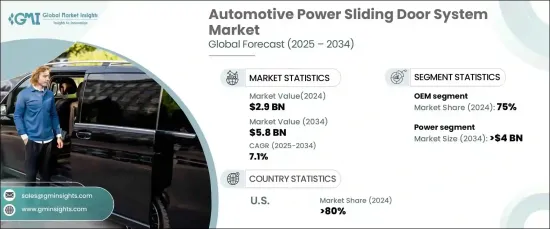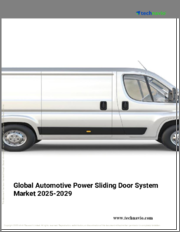
|
시장보고서
상품코드
1665013
자동차용 파워 슬라이드 도어 시스템 시장 기회, 성장 촉진 요인, 산업 동향 분석, 예측(2025-2034년)Automotive Power Sliding Door System Market Opportunity, Growth Drivers, Industry Trend Analysis, and Forecast 2025 - 2034 |
||||||
자동차용 파워 슬라이드 도어 시스템 세계 시장은 2024년에 29억 달러에 달했으며, 2025년부터 2034년까지 연평균 복합 성장률(CAGR) 7.1%로 성장할 것으로 예측됩니다.
고급차와 프리미엄카에 대한 수요 증가가 이 성장의 큰 원동력이 되고 있습니다. 소비자는 자동차에 쾌적성, 편리성, 선진 기능을 적극적으로 요구하고 있어, 이것이 SUV, 밴, 미니밴에 파워 슬라이드 도어 시스템을 널리 채용하는 요인이 되고 있습니다. 이러한 시스템은 접근성을 높일 뿐만 아니라 가족용 차량에도 적용되어 출입을 현저하게 용이하게 합니다. 자동차 제조업체는 제스처 컨트롤과 자동 센서 등의 혁신적인 기술을 활용하여 사용자 경험을 더욱 향상시키고 승객의 편의성과 자동화를 중시하는 경향에 보조를 맞추고 있습니다. 게다가 전기자동차 생산량이 증가함에 따라 소비자는 합리화된 기능성을 갖춘 현대적이고 하이테크에 정통한 자동차에 끌리면서 동력조작기능의 채택이 촉진되었습니다.

시장은 기능별로 수동식과 전동식으로 나뉩니다. 2024년 시장 점유율은 전동식이 70%를 차지했고 2034년에는 40억 달러에 달할 것으로 예측됩니다. 이 성장은 최신 자동차의 핸즈프리 작동과 원활한 기능성에 대한 소비자의 선호도 증가를 반영합니다. 파워 슬라이드 도어는 좁은 주차 공간에서 특히 유리하며, 쉽게 열고 닫을 수 있으며 중량물의 적재도 용이합니다. 이러한 이점으로부터, 특히 편리성과 기술적 세련성이 높게 평가되는 고급차나 전기자동차에서는 전동식 시스템이 선호되는 선택지가 되고 있습니다.
| 시장 범위 | |
|---|---|
| 시작연도 | 2024 |
| 예측연도 | 2025-2034 |
| 시작금액 | 29억 달러 |
| 예측 금액 | 58억 달러 |
| CAGR | 7.1% |
판매 채널을 고려하면 시장은 OEM과 애프터마켓으로 구분됩니다. 2024년 시장 점유율은 OEM이 75%를 차지했으며 예측 기간 동안에도 그 우위성은 유지될 것으로 보입니다. 자동차 제조업체는 공급업체와 광범위하게 협력하여 선진 기술을 차량 설계에 통합하여 전력 슬라이드 도어 시스템의 채용이 증가하고 있습니다. OEM 각 회사는 자동 개폐 기구, 제스처 컨트롤, 자동 센서 등의 기능을 새로운 모델에 탑재하는 최전선에 서 있습니다. 이러한 발전은 첨단 기술과 사용자 친화적인 차량 솔루션을 요구하는 소비자 수요에 부응하며 시장 성장을 견인하는 OEM의 중요성을 높입니다.
미국에서는 자동차용 파워 슬라이드 도어 시스템 시장이 2024년에 80%의 점유율을 차지하고 있습니다. SUV 및 미니밴과 같은 가족용 차량에 대한 강한 선호도는 편리성, 안전성, 사용 편의성에 대한 수요를 뒷받침합니다. 파워 슬라이드 도어는 미국 소비자들에게 중요한 고려사항이 되고 있으며, 특히 운전 체험을 향상시키는 기능을 우선하고 있습니다.
목차
제1장 조사 방법과 조사 범위
- 조사 디자인
- 조사 접근
- 데이터 수집 방법
- 기본 추정과 계산
- 기준연도의 산출
- 시장추계의 주요 동향
- 예측 모델
- 1차 조사와 검증
- 1차 정보
- 데이터 마이닝 소스
- 시장 범위와 정의
제2장 주요 요약
제3장 업계 인사이트
- 생태계 분석
- 원재료 제공업체
- 부품 제조업체
- 제조업자
- 유통업체
- 최종 용도
- 공급자의 상황
- 이익률 분석
- 기술 혁신의 상황
- 특허 분석
- 주요 뉴스와 대처
- 규제 상황
- 사례 연구
- 영향요인
- 성장 촉진요인
- 편의성과 고급 기능에 대한 소비자 수요
- 선진 안전 기능의 채용 확대
- 문기구의 기술적 진보
- 전기자동차와 자율주행차의 성장
- 업계의 잠재적 위험 및 과제
- 높은 생산 비용
- 내구성과 유지보수에 대한 우려
- 성장 촉진요인
- 성장 가능성 분석
- Porter's Five Forces 분석
- PESTEL 분석
제4장 경쟁 구도
- 소개
- 기업 점유율 분석
- 경쟁 포지셔닝 매트릭스
- 전략 전망 매트릭스
제5장 시장 추정 및 예측 : 기능별, 2021-2034년
- 주요 동향
- 매뉴얼
- 파워
제6장 시장 추정 및 예측 : 메커니즘별, 2021-2034년
- 주요 동향
- 전기식
- 공압 시스템
- 하이브리드 시스템
제7장 시장 추정 및 예측 : 차량별, 2021-2034년
- 주요 동향
- 미니밴
- 밴
- 대형 SUV
- 버스
제8장 시장 추정 및 예측 : 판매 채널별, 2021-2034년
- 주요 동향
- OEM
- 애프터마켓
제9장 시장 추정 및 예측 : 지역별, 2021-2034년
- 주요 동향
- 북미
- 미국
- 캐나다
- 유럽
- 영국
- 독일
- 프랑스
- 이탈리아
- 스페인
- 러시아
- 북유럽
- 아시아태평양
- 중국
- 인도
- 일본
- 호주
- 한국
- 동남아시아
- 라틴아메리카
- 브라질
- 멕시코
- 아르헨티나
- 중동 및 아프리카
- UAE
- 남아프리카
- 사우디아라비아
제10장 기업 프로파일
- Aisin Seiki
- Aptive
- Autoliv
- Bosch
- Brose
- Delphi
- Denso
- Hella
- Hitachi
- Johnson
- JTEKT
- Kiekert AG
- Lear
- Magna
- Mahle
- Panasonic
- Pioneer
- Valeo SA
- Yazaki
- ZF Friedrichshafen
The Global Automotive Power Sliding Door System Market was valued at USD 2.9 billion in 2024 and is projected to grow at a CAGR of 7.1% from 2025 to 2034. The increasing demand for luxury and premium vehicles is a significant driver of this growth. Consumers are actively seeking comfort, convenience, and advanced features in their vehicles, which has led to the widespread adoption of power sliding door systems in SUVs, vans, and minivans. These systems not only enhance accessibility but also cater to family-oriented vehicles, making entry and exit remarkably easy. Automakers are leveraging innovative technologies, such as gesture controls and automated sensors, to further improve the user experience, aligning with the growing emphasis on passenger convenience and automation. Additionally, the rise in electric vehicle production has fueled the adoption of power-operated features, as consumers gravitate toward modern, tech-savvy vehicles with streamlined functionalities.

By function, the market is divided into manual and power-operated systems. In 2024, the power-operated segment dominated with a 70% market share and is anticipated to reach USD 4 billion by 2034. This growth reflects increasing consumer preferences for hands-free operation and seamless functionality in modern vehicles. Power sliding doors are particularly advantageous in tight parking spaces, allowing effortless opening and closing while also facilitating the loading of heavy items. These benefits have made power-operated systems a preferred choice, especially in premium and electric vehicles, where convenience and technological sophistication are highly valued.
| Market Scope | |
|---|---|
| Start Year | 2024 |
| Forecast Year | 2025-2034 |
| Start Value | $2.9 Billion |
| Forecast Value | $5.8 Billion |
| CAGR | 7.1% |
When considering sales channels, the market is segmented into OEM and aftermarket categories. In 2024, the OEM segment accounted for 75% of the market share and is expected to maintain its dominance throughout the forecast period. Automakers are collaborating extensively with suppliers to integrate advanced technologies into their vehicle designs, leading to increased adoption of power sliding door systems. OEMs have been at the forefront of incorporating features like self-closing mechanisms, gesture control, and automated sensors into new models. These advancements cater to consumer demands for high-tech and user-friendly vehicle solutions, reinforcing the importance of OEMs in driving market growth.
In the United States, the automotive power sliding door system market held an 80% share in 2024. The strong preference for family-friendly vehicles, such as SUVs and minivans, underscores the demand for convenience, safety, and ease of use. Power sliding doors have become a key consideration for American consumers, especially as they prioritize features that enhance their driving experience.
Table of Contents
Chapter 1 Methodology & Scope
- 1.1 Research design
- 1.1.1 Research approach
- 1.1.2 Data collection methods
- 1.2 Base estimates & calculations
- 1.2.1 Base year calculation
- 1.2.2 Key trends for market estimation
- 1.3 Forecast model
- 1.4 Primary research and validation
- 1.4.1 Primary sources
- 1.4.2 Data mining sources
- 1.5 Market scope & definition
Chapter 2 Executive Summary
- 2.1 Industry 3600 synopsis, 2021 - 2034
Chapter 3 Industry Insights
- 3.1 Industry ecosystem analysis
- 3.1.1 Raw material providers
- 3.1.2 Component providers
- 3.1.3 Manufacture
- 3.1.4 Distributors
- 3.1.5 End Use
- 3.2 Supplier landscape
- 3.3 Profit margin analysis
- 3.4 Technology & innovation landscape
- 3.5 Patent analysis
- 3.6 Key news & initiatives
- 3.7 Regulatory landscape
- 3.8 Case study
- 3.9 Impact forces
- 3.9.1 Growth drivers
- 3.9.1.1 Consumer demand for convenience and luxury features
- 3.9.1.2 Growing adoption of advanced safety features
- 3.9.1.3 Technological advancements in door mechanisms
- 3.9.1.4 Growth of electric and autonomous vehicles
- 3.9.2 Industry pitfalls & challenges
- 3.9.2.1 High production costs
- 3.9.2.2 Durability and maintenance concerns
- 3.9.1 Growth drivers
- 1.1 Growth potential analysis
- 1.2 Porter’s analysis
- 1.3 PESTEL analysis
Chapter 4 Competitive Landscape, 2024
- 2.1 Introduction
- 2.2 Company market share analysis
- 2.3 Competitive positioning matrix
- 2.4 Strategic outlook matrix
Chapter 5 Market Estimates & Forecast, By Function, 2021 - 2034 ($Bn, Units)
- 3.1 Key trends
- 3.2 Manual
- 3.3 Power
Chapter 6 Market Estimates & Forecast, By Mechanism, 2021 - 2034 ($Bn, Units)
- 4.1 Key trends
- 4.2 Electric system
- 4.3 Pneumatic system
- 4.4 Hybrid system
Chapter 7 Market Estimates & Forecast, By Vehicle, 2021 - 2034 ($Bn, Units)
- 5.1 Key trends
- 5.2 Minivans
- 5.3 Vans
- 5.4 Large SUV
- 5.5 Buses
Chapter 8 Market Estimates & Forecast, By Sales Channel, 2021 - 2034 ($Bn, Units)
- 6.1 Key trends
- 6.2 OEM
- 6.3 Aftermarket
Chapter 9 Market Estimates & Forecast, By Region, 2021 - 2034 ($Bn, Units)
- 7.1 Key trends
- 7.2 North America
- 7.2.1 U.S.
- 7.2.2 Canada
- 7.3 Europe
- 7.3.1 UK
- 7.3.2 Germany
- 7.3.3 France
- 7.3.4 Italy
- 7.3.5 Spain
- 7.3.6 Russia
- 7.3.7 Nordics
- 7.4 Asia Pacific
- 7.4.1 China
- 7.4.2 India
- 7.4.3 Japan
- 7.4.4 Australia
- 7.4.5 South Korea
- 7.4.6 Southeast Asia
- 7.5 Latin America
- 7.5.1 Brazil
- 7.5.2 Mexico
- 7.5.3 Argentina
- 7.6 MEA
- 7.6.1 UAE
- 7.6.2 South Africa
- 7.6.3 Saudi Arabia
Chapter 10 Company Profiles
- 8.1 Aisin Seiki
- 8.2 Aptive
- 8.3 Autoliv
- 8.4 Bosch
- 8.5 Brose
- 8.6 Delphi
- 8.7 Denso
- 8.8 Hella
- 8.9 Hitachi
- 8.10 Johnson
- 8.11 JTEKT
- 8.12 Kiekert AG
- 8.13 Lear
- 8.14 Magna
- 8.15 Mahle
- 8.16 Panasonic
- 8.17 Pioneer
- 8.18 Valeo SA
- 8.19 Yazaki
- 8.20 ZF Friedrichshafen



















